Sea State Monitoring by Ship Motion Measurements Onboard a Research Ship in the Antarctic Waters
Abstract
1. Introduction
2. Sea State Monitoring
2.1. Ship Motion Measurements
2.2. Assessment of Weather Forecasting Data
2.3. Ship Motion Analysis and Wave Spectrum Resembling
3. Experiment Data
4. Benchmark Study
4.1. First Data Set—7 January 2020
4.2. Second Data Set—8 January 2020
4.3. Third Data Set—14 February 2020
5. Conclusions
- The wave spectrum resembling procedure makes it possible to efficiently assess the sea state parameters, in terms of significant wave height and wave peak period;
- The analysis of ship motions is more effective, as regards the other one based on ship accelerations, to assess the main sea state parameters.
Author Contributions
Funding
Institutional Review Board Statement
Informed Consent Statement
Data Availability Statement
Acknowledgments
Conflicts of Interest
References
- Pascoal, R.; Guedes Soares, C.; Sørensen, J. Ocean wave spectral estimation using vessel wave frequency motions. J. Offshore Mech. Arct. Eng. 2007, 129, 90–96. [Google Scholar] [CrossRef]
- Gaglione, S.; Piscopo, V.; Scamardella, A. The overall motion induced interruptions as operability criterion for fishing vessels. J. Mar. Sci. Technol. 2016, 21, 517–532. [Google Scholar] [CrossRef]
- Scamardella, A.; Piscopo, V. Passenger ship seakeeping optimization by the Overall Motion Sickness Incidence. Ocean Eng. 2014, 76, 86–97. [Google Scholar] [CrossRef]
- Pennino, S.; Gaglione, S.; Innac, A.; Piscopo, V.; Scamardella, A. Development of a New Ship Adaptive Weather Routing Model Based on Seakeeping Analysis and Optimization. J. Mar. Sci. Eng. 2020, 8, 270. [Google Scholar] [CrossRef]
- Takekuma, K.; Takahashi, T. On the Evaluation of Sea Spectra Based on the Measured Ship Motions. Trans. West-Jpn. Soc. Naval Archit. 1973, 45, 51–57. [Google Scholar]
- Isobe, M.; Kondo, K.; Horikawa, K. Extension of MLM for Estimating Direction Wave Spectrum. In Proceedings of the Symposium on Description and Modeling of Direction Seas, Danish Hydraulic Institute and Danish Maritime Institute, Copenhagen, Denmark, 18–20 June 1984; Volume A-6. [Google Scholar]
- Kobune, K.; Hashimoto, N. Estimation of Directional Spectra from the Maximum Entropy Principle. In Proceedings of the 5th International Offshore Mechanics and Arctic Engineering Symposium (OMAE), Tokyo, Japan, 13–18 April 1986; pp. 80–85. [Google Scholar]
- Iseki, T.; Ohtsu, K. Bayesian estimation of directional wave spectra based on ship motions. Control Eng. Pract. 2000, 8, 215–219. [Google Scholar]
- Iseki, T.; Terada, D. Bayesian estimation of direction wave spectra for ship guidance systems. Int. J. Offshore Pol. Eng. 2002, 12, 25–30. [Google Scholar]
- Nielsen, U.D. Estimations of on-site direction wave spectra from measured ship responses. Mar. Struct. 2006, 19, 33–69. [Google Scholar] [CrossRef]
- Nielsen, U.D.; Andersen, I.M.V.; Koning, J. Comparisons of means for estimating sea states from an advancing large containership. In Proceedings of the 12th PRADS, Changwon, Korea, 20–25 October 2013. [Google Scholar]
- Montazeri, N.; Nielsen, U.D.; Jensen, J.J. Estimation of wind sea and swell using shipboard measurements—A refined parametric modelling approach. Appl. Ocean Res. 2016, 54, 73–86. [Google Scholar] [CrossRef]
- Brodtkorb, A.H.; Nielsen, U.D.; Sørensen, A. Online wave estimation using vessel motion measurements. In Proceedings of the 11th IFAC Conference on Control Applications in Marine Systems, Robotics, and Vehicles (CAMS), Opatija, Croatia, 10–12 September 2018. [Google Scholar]
- Nielsen, U.D.; Diez, J. Ocean wave spectrum estimation using measured vessel motions from an in-service containership. Mar. Struct. 2020, 69, 102682. [Google Scholar] [CrossRef]
- Nielsen, U.D. A concise account of techniques available for shipboard sea state estimation. Ocean Eng. 2017, 129, 352–362. [Google Scholar] [CrossRef]
- Pascoal, R.; Soares, C.G. Kalman filtering of vessel motions for ocean wave directional spectrum estimation. Ocean Eng. 2009, 36, 477–488. [Google Scholar] [CrossRef]
- Pascoal, R.; Perera, L.P.; Soares, C.G. Estimation of directional spectra from ship motions sea trials. Ocean Eng. 2017, 132, 126–137. [Google Scholar] [CrossRef]
- Piscopo, V.; Gaglione, S.; Scamardella, A. A new wave spectrum resembling procedure based on ship motion analysis. Ocean Eng. 2020, 201, 107137. [Google Scholar] [CrossRef]
- Available online: https://se.mathworks.com/help/supportpkg/mobilesensor/ug/phoneorv2.gif (accessed on 26 May 2020).
- WMO. Introduction to GRIB Edition 1 and GRIB Edition 2. Available online: https://www.wmo.int/pages/prog/www/WMOCodes/Guides/GRIB/Introduction_GRIB1-GRIB2.pdf (accessed on 18 November 2020).
- Komen, G.J.; Cavaleri, L.; Donelan, M.; Hasselmann, K.; Janssen, P.A.E.M.; Hasselmann, S. Dynamics and Modelling of Ocean Waves; Cambridge University Press (CUP): Cambridge, UK, 1994. [Google Scholar]
- Salvesen, N.; Tuck, E.O.; Faltinsen, O. Ship motions and sea loads. SNAME Trans. 1970, 6, 1–30. [Google Scholar]
- Babarit, A.; Delhommeau, G. Theoretical and numerical aspects of the open source BEM solver NEMOH. In Proceedings of the 11th European Wave and Tidal Energy Conference, Nantes, France, 6–11 September 2015. [Google Scholar]
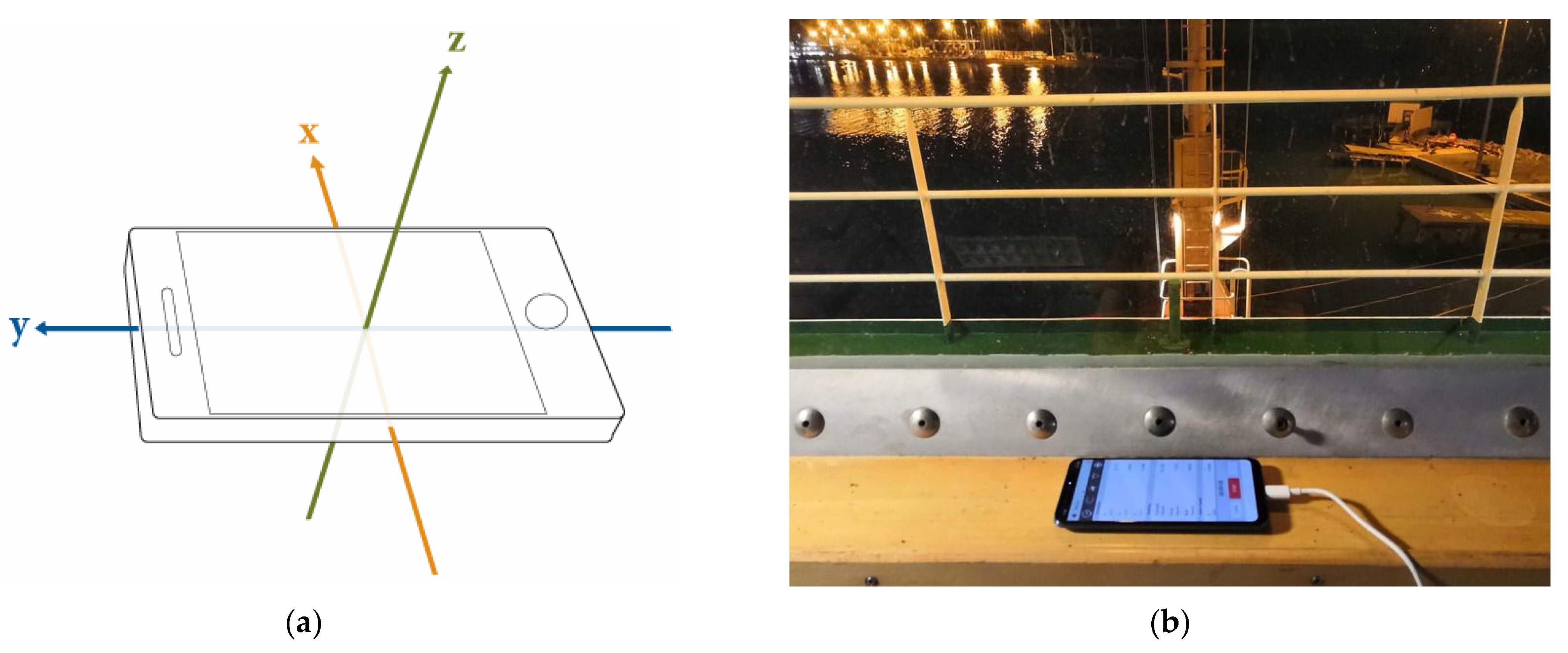
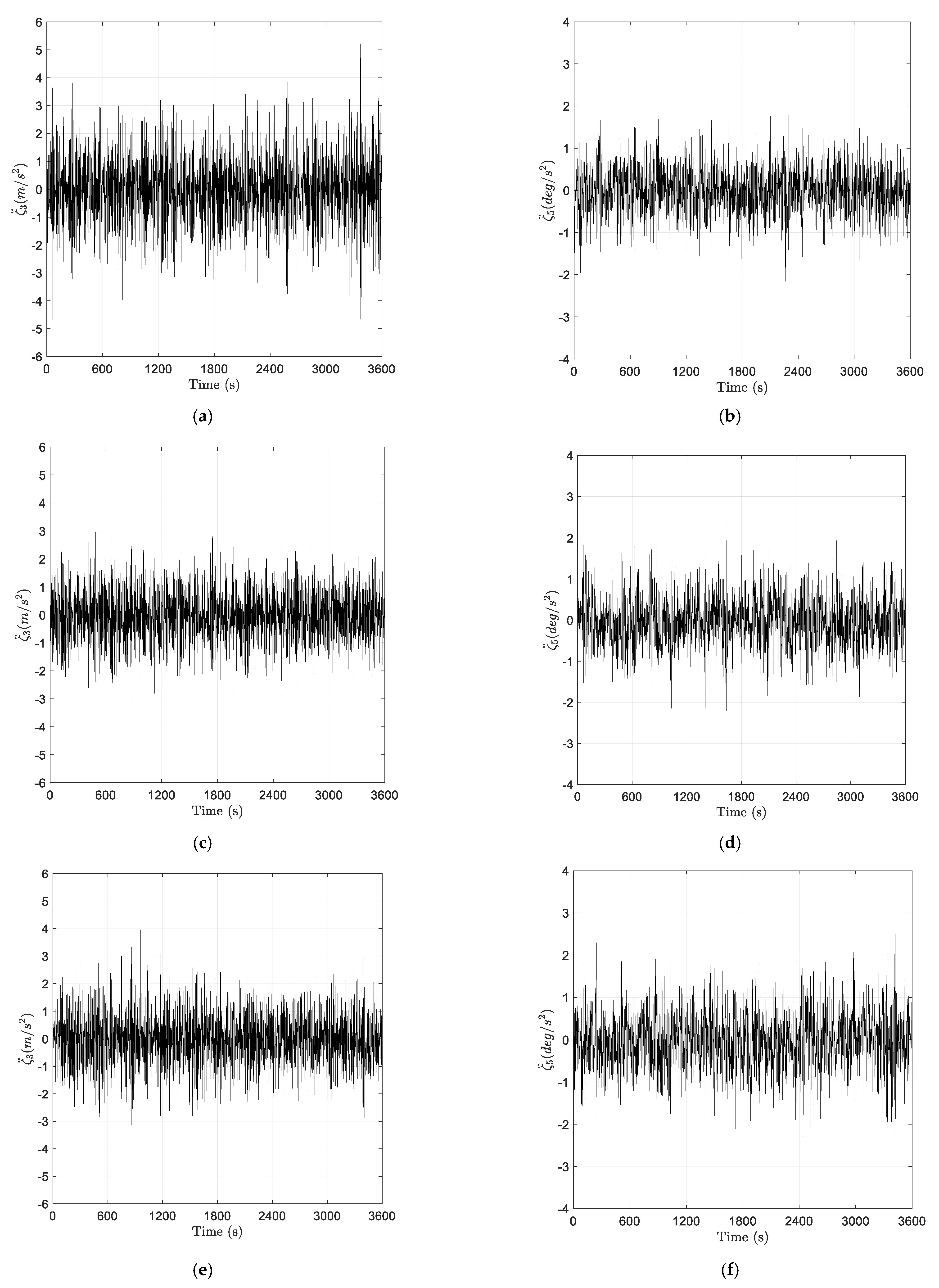
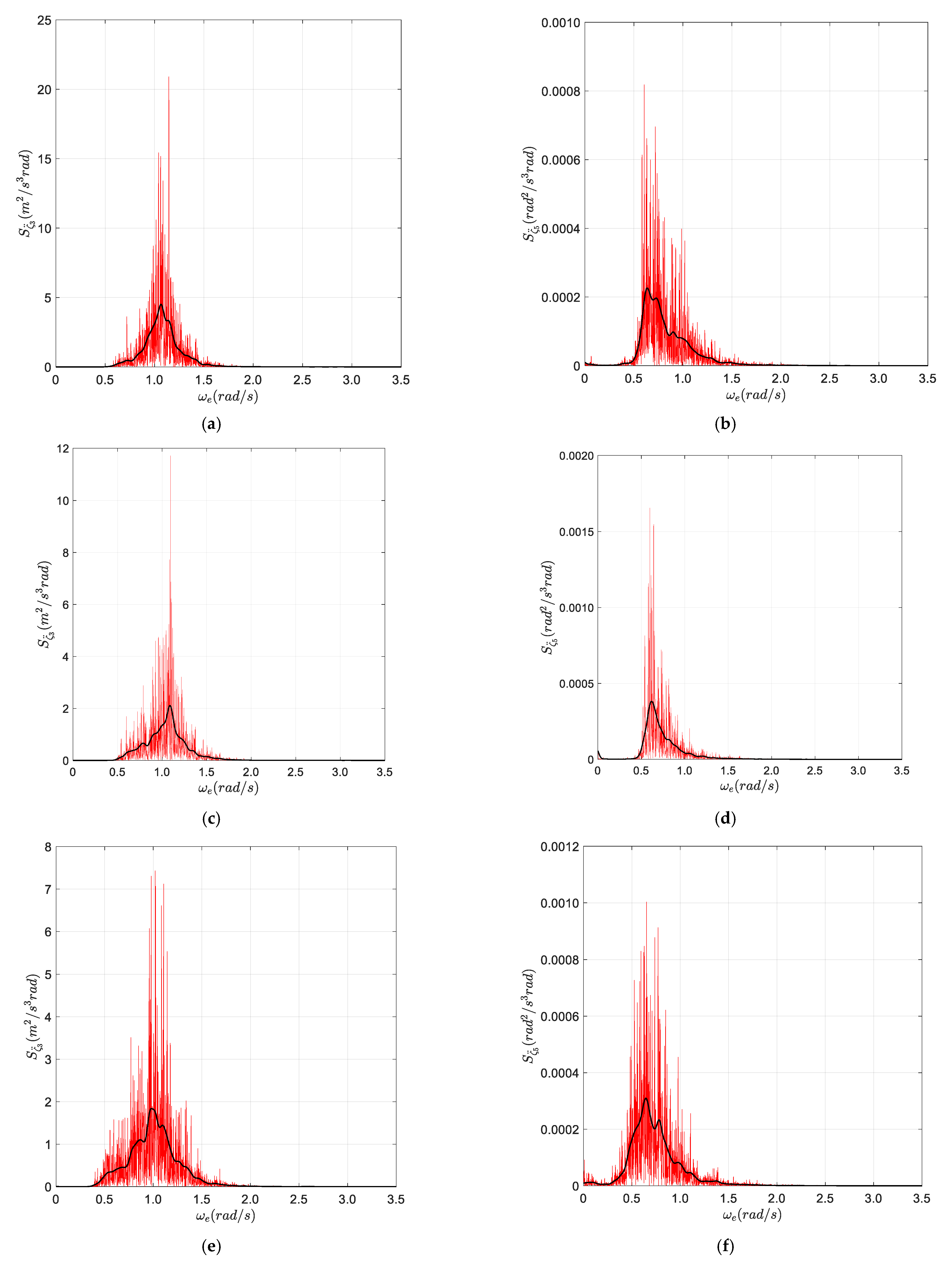
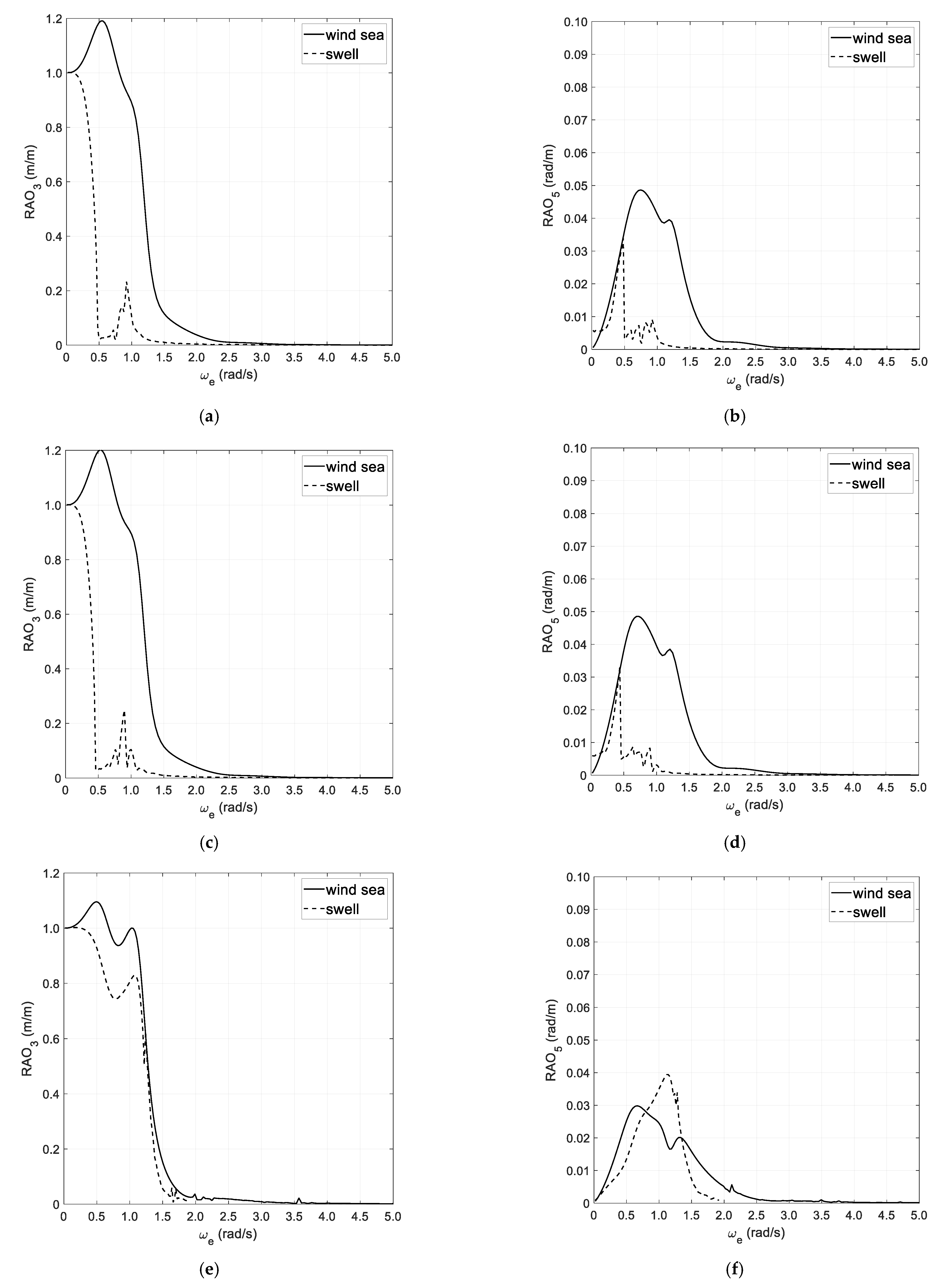
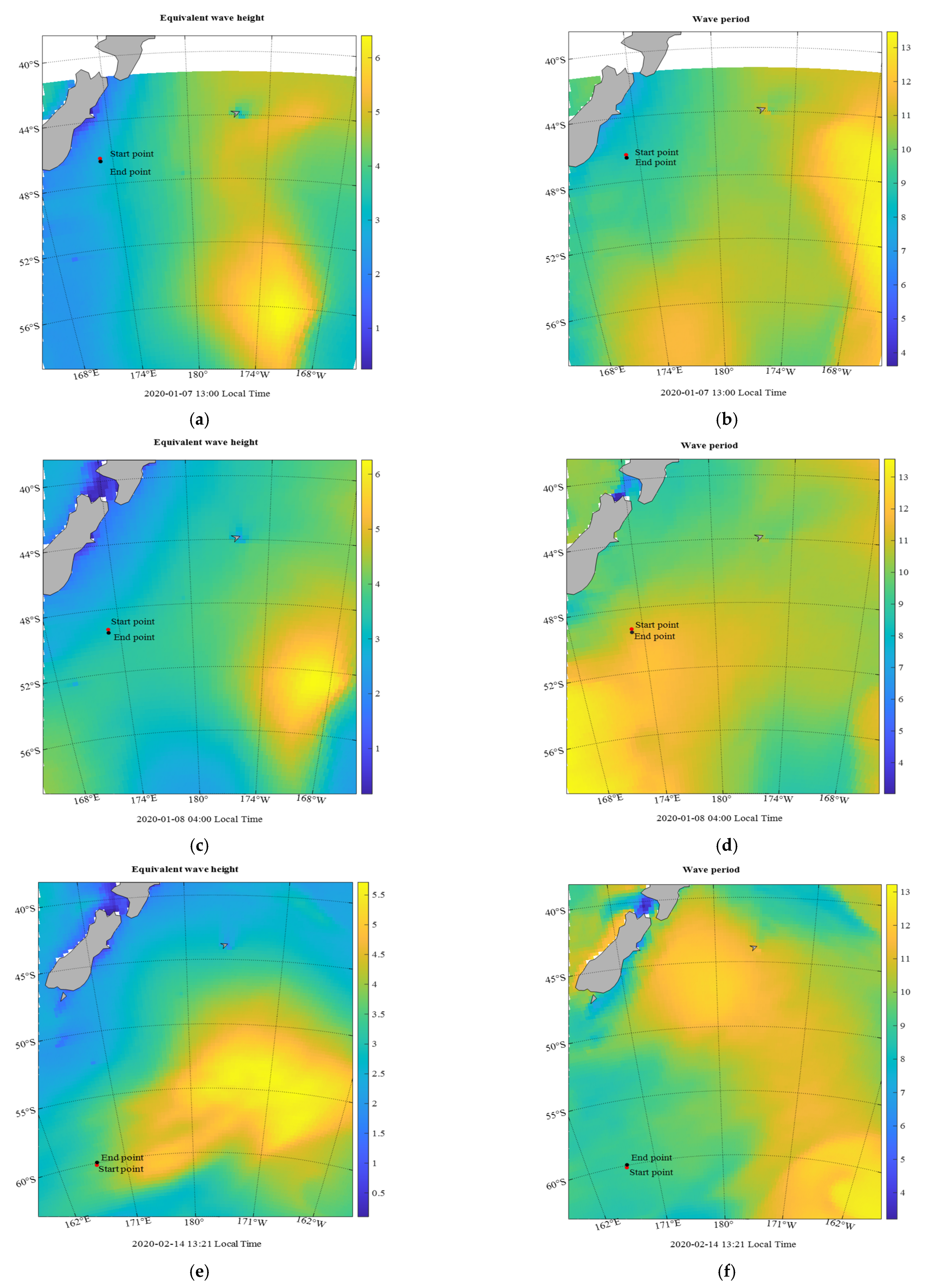
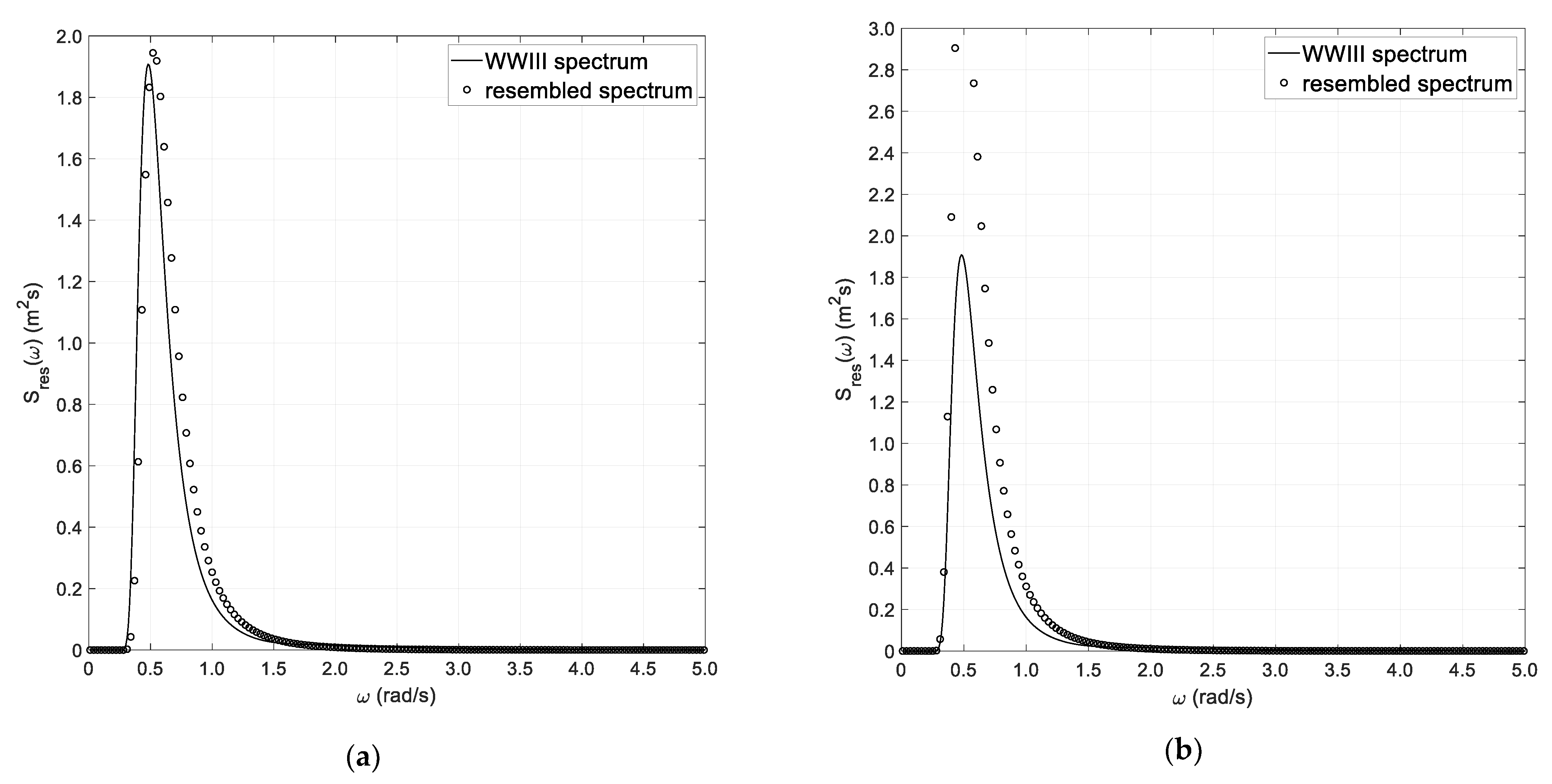
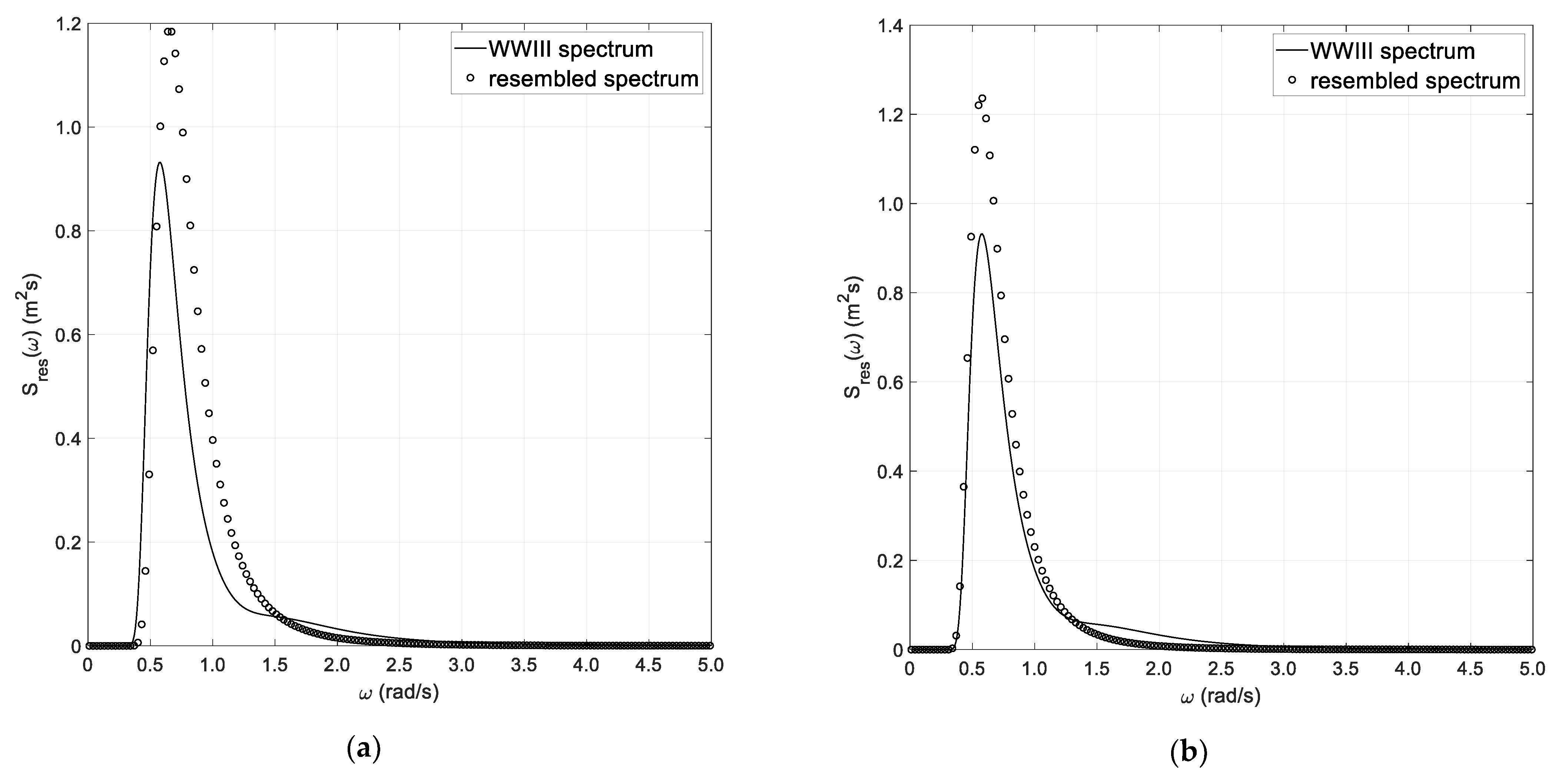

| Day | Start Point | End Point | Distance (nm) | Heading Angle—Wind (deg) | Heading Angle—Swell (deg) |
|---|---|---|---|---|---|
| 7 January 2020 13:00–14:00 (local time) | 46°19′44.90″ S 173°1′24.13″ E | 46°31′5.88″ S 173°1′50.77″ E | 11.36 | 173.63 | 29.68 |
| 8 January 2020 04:00–05:00 (local time) | 49°16′14.16″ S 173°4′25.032″ E | 49°28′ 35.08″ S 173°3′59.33″ E | 12.36 | 167.35 | 32.04 |
| 14 February 2020 13:21–14:21 (local time) | 60°9′20.56″ S 167°4′46.49″ E | 59°57′31.14″ S 167°11′37.75″ E | 12.32 | 106.99 | 78.43 |
| Length overall | 80.00 | m |
| Length between perpendiculars | 72.40 | m |
| Beam on WL | 17.00 | m |
| Design draught | 6.15 | m |
| Displacement | 4736 | t |
| Waterplane area | 1074 | m2 |
| Block coefficient | 0.599 |
| HS (m) | TP (s) | |
|---|---|---|
| Data from WWIII | 3.243 | 12.803 |
| Resembled sea spectrum—motions | 3.391 (+4.56%) | 11.900 (−7.05%) |
| Resembled sea spectrum—accelerations | 4.360 (+34.44%) | 12.900 (+0.75%) |
| HS (m) | TP (s) | |
|---|---|---|
| Data from WWIII | 2.576 | 10.225 |
| Resembled sea spectrum—motions | 2.950 (+14.52%) | 9.600 (−6.11%) |
| Resembled sea spectrum—accelerations | 2.812 (+9.16%) | 11.000 (+7.57%) |
| HS (m) | TP (s) | |
|---|---|---|
| Data from WWIII | 4.441 | 9.001 |
| Resembled sea spectrum—motions | 4.346 (−2.14%) | 9.300 (+3.32%) |
| Resembled sea spectrum—accelerations | 5.167 (+16.34%) | 9.400 (+4.43%) |
Publisher’s Note: MDPI stays neutral with regard to jurisdictional claims in published maps and institutional affiliations. |
© 2021 by the authors. Licensee MDPI, Basel, Switzerland. This article is an open access article distributed under the terms and conditions of the Creative Commons Attribution (CC BY) license (http://creativecommons.org/licenses/by/4.0/).
Share and Cite
Pennino, S.; Angrisano, A.; Corte, V.D.; Ferraioli, G.; Gaglione, S.; Innac, A.; Martellato, E.; Palumbo, P.; Piscopo, V.; Rotundi, A.; et al. Sea State Monitoring by Ship Motion Measurements Onboard a Research Ship in the Antarctic Waters. J. Mar. Sci. Eng. 2021, 9, 64. https://doi.org/10.3390/jmse9010064
Pennino S, Angrisano A, Corte VD, Ferraioli G, Gaglione S, Innac A, Martellato E, Palumbo P, Piscopo V, Rotundi A, et al. Sea State Monitoring by Ship Motion Measurements Onboard a Research Ship in the Antarctic Waters. Journal of Marine Science and Engineering. 2021; 9(1):64. https://doi.org/10.3390/jmse9010064
Chicago/Turabian StylePennino, Silvia, Antonio Angrisano, Vincenzo Della Corte, Giampaolo Ferraioli, Salvatore Gaglione, Anna Innac, Elena Martellato, Pasquale Palumbo, Vincenzo Piscopo, Alessandra Rotundi, and et al. 2021. "Sea State Monitoring by Ship Motion Measurements Onboard a Research Ship in the Antarctic Waters" Journal of Marine Science and Engineering 9, no. 1: 64. https://doi.org/10.3390/jmse9010064
APA StylePennino, S., Angrisano, A., Corte, V. D., Ferraioli, G., Gaglione, S., Innac, A., Martellato, E., Palumbo, P., Piscopo, V., Rotundi, A., & Scamardella, A. (2021). Sea State Monitoring by Ship Motion Measurements Onboard a Research Ship in the Antarctic Waters. Journal of Marine Science and Engineering, 9(1), 64. https://doi.org/10.3390/jmse9010064








